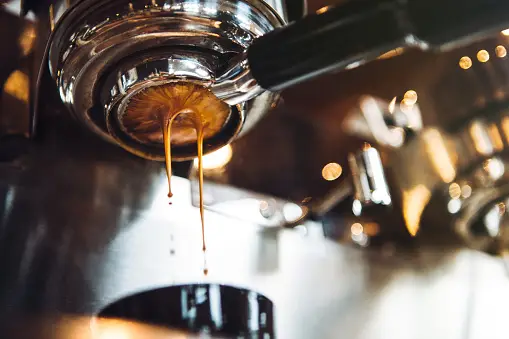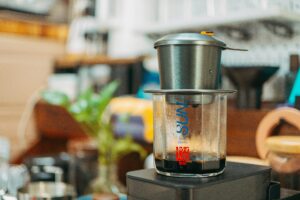Espresso, the concentrated burst of flavor and energy that serves as the lifeblood for many, was once the domain of professionals and high-end coffee shops. However, with the rise of the home barista movement, more coffee enthusiasts are realizing they don’t necessarily have to leave their kitchens to enjoy a quality shot of espresso. The burning question for aficionados and novices alike is, ‘can you make espresso in a coffee maker?’ Today, I’m here to not only answer that yes, you can indeed craft espresso at home, but also to take you through the intricate world of transforming ground coffee into that authentic, rich java that aficionados crave.
Table of contents

The Basics: Espresso Defined
Before we venture into the realm of home brewing, it’s crucial to understand what distinguishes espresso from other coffees. Essentially, it’s the method of extraction, characterized by the high pressure under which water is forced through finely-ground coffee. The result is a velvety, thick liquid with a distinctive layer of crema, the caramel-colored foam that crowns a well-pulled shot.
Best Espresso machine

De’Longhi Magnifica Start Fully Automatic Espresso Machine with Automatic Milk Frother
- Five One-Touch Recipes with Color Icons; Espresso, Cappuccino, Latte Macchiato, Coffee, and Hot Water.
- Built-in Conical Burr Grinder with 13 settings.
- LatteCrema System for texturing milk, or milk alternatives for lattes and cappuccinos.
- Removable and dishwasher-safe parts for easy clean up.
Yes, It’s Possible: Making Espresso in a Coffee Maker
Coffee makers come in various forms, and not all of them are cut out for the detailed process of making true espresso. Here is a detailed analysis of different coffee makers and their suitability for brewing espresso at home.
Traditional Espresso Machines
The crème de la crème for home baristas, traditional espresso machines, employ a pump mechanism to produce ideal pressure for extracting coffee. They allow for precise temperature control and the ability to tamp the grind with the correct pressure – all critical components of pulling a tasty shot.
Stovetop Espresso Makers (Moka Pots)
Though not true espresso by the strictest definition, Moka pots produce a strong coffee that’s similar in taste and concentration to espresso. They work by creating steam pressure from boiling water in the lower chamber, which pushes water upwards through the grounds into the upper chamber.
Pod Coffee Makers (Nespresso, Keurig K-Café, etc.)
These machines, often touted for convenience, use pre-packaged pods containing coffee, eliminating the need for grinding or tamping. While not favored by purists, they have gained popularity for consistently producing a decent simulacrum of espresso.
French Press and Aeropress
Although beloved in their own right, neither the French Press nor the Aeropress are designed to generate the intense pressure needed for true espresso. They make strong, full-bodied coffee, but the outcome lacks the signature crema and concentration of actual espresso.
The Step-by-Step Guide to Crafting Espresso at Home
Irrespective of your chosen brewing method, the approach to making espresso at home is anchored in a set of fundamental steps. Here is a comprehensive guide to brewing the perfect shot of espresso, tailored to mimic the process of professional baristas.
Step 1: Start with Fresh, High-Quality Coffee
Espresso is an unforgiving drink. The quality of your starting coffee and its freshness will significantly impact the final flavor. Invest in beans from a reputable source and ensure they’re roasted for espresso (or a roast that is specifically recommended for fine grinds and pressure brewing).
Step 2: Prepare and Maintain Your Equipment
Cleanliness is next to godliness when it comes to espresso. Ensure your coffee maker, whether a Moka pot or a full-fledged machine, is entirely clean, and don’t forget to warm up the machine to the appropriate temperature before brewing to avoid any bitterness from uneven extraction.
Step 3: Grind Correctly
Your coffee must be ground to a fine consistency, resembling table salt. This fine grind is necessary to slow the flow of water through the coffee, allowing for optimal extraction during the 25-30 seconds it takes to brew a shot.
Step 4: Tamp Evenly and Firmly
If you’re using an espresso machine, distribute your coffee grounds evenly in the filter basket, and tamp them down with about 30 pounds of force. This part of the process is crucial for a proper extraction. Incomplete or inconsistent tamping can lead to an underwhelming shot.
Step 5: Time the Shot
The ideal extraction time for a double shot of espresso is 25-30 seconds. If it’s too quick, your espresso will be under-extracted, resulting in a sour taste. If it’s too slow, it will be over-extracted, which can lead to a bitter taste.
Step 6: Observe the Crema
A good crema is a sign of a well-pulled espresso. It should coat the surface of your shot and be a rich brown color with reddish hues, almost bronze-like.
Recipe: The Classic Espresso Shot at Home
Ingredients:
- 18 grams of freshly roasted coffee beans
- Filtered water
Equipment:
- Espresso machine or Moka pot
- Burr grinder
- Tamper
- Espresso cup
Instructions:
- Grind Your Coffee: Start by grinding your coffee beans to a fine consistency, resembling powdered sugar. This fine grind is vital for achieving the dense, rich texture that defines an espresso.
- Heat Your Water: If using an espresso machine, turn it on and allow it to warm up according to the manufacturer’s instructions. For a Moka pot, fill the bottom chamber with cold filtered water up to the fill line.
- Prepare Your Coffee: Place 18 grams of your ground coffee into the espresso machine’s portafilter or the Moka pot’s filter basket. Use the tamper to press the coffee grounds down firmly and evenly.
- Brew Your Espresso: For an espresso machine, lock the portafilter into place and press the button to start the extraction. Aim for a 25-30 second brew time. For a Moka pot, place it on the stove over medium heat. When the water boils, it will pass through the coffee into the top chamber. Remove from heat as soon as the upper chamber is full, usually within a few minutes.
- Serve Immediately: Pour your freshly brewed espresso into a pre-warmed cup. Observe the crema on top and savor the rich aroma before enjoying.
Tips for Perfection:
- Always use freshly roasted and ground coffee for the best flavor.
- Experiment with the amount of coffee and tamping pressure to find your perfect shot.
- Clean your equipment after every use to maintain the best taste.

Tips for Perfecting Your Home Espresso Technique
Making great coffee is as much an art as a science. Here are some expert tips to help you refine your technique and take your home espresso to the next level.
Invest in a Quality Grinder
Espresso demands precision, and a good coffee grinder – preferably a burr grinder – is essential. Pre-ground coffee may not be consistent enough for the level of precision required to make a stellar shot.
Learn to “Ride the Wave”
When using a traditional espresso machine, you’ll want to “ride the wave,” essentially meaning to watch for changes in the color and flow of the coffee as it pours. This can help you extract the optimal flavors from your beans.
Dial in Your Grind and Shot Time
The ideal grind and shot time will vary from bean to bean and even from day to day as the weather and age of the beans change. Spend time dialing in these variables to find the perfect combination for your setup and taste.
Conclusion
The art of making espresso at home is a rewarding pursuit that allows you to savor one of life’s great indulgences anytime you please. Whether you’re using a stovetop Moka pot, a high-end machine, or even a convenient pod system, the principles of good espresso-making remain the same. With practice, patience, and a willingness to experiment, you can not only replicate the flavor and experience of a coffee shop but, for some, even surpass it. Now that you’re equipped with the knowledge and passion for brewing at home, it’s time to grab your favorite blend, roll up your sleeves, and start pulling those perfect shots. Your tastebuds will thank you.






